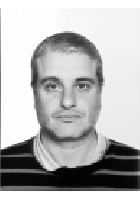LARENA Julien
Fonction : Enseignant-chercheur
Organisme : UM2
Maître de Conférences
(HDR)
Thème de Recherche: LUPM/Particules, Astroparticules, Cosmologie : Théorie
julien.larena

umontpellier.fr
0467143770
Bureau: 11, Etg: 4, Bât: 21
Administration Locale:- Membre du conseil du département enseignement
- Responsable de formations
|
Activités de Recherche: |
| Je m'intéresse aux effets relativistes en cosmologie, et plus particulièrement dans la formation et l'observation des grandes structures. Plus récemment, une partie importante de mon activité s'articule autour de la compréhension et de la modélisation des phénomènes de lentillage fort dans l'univers inhomogène. |
Domaines de Recherche: - Planète et Univers/Astrophysique/Cosmologie et astrophysique extra-galactique
- Physique/Relativité Générale et Cosmologie Quantique
|
Productions scientifiques :


|

|
Measuring line-of-sight shear with Einstein rings: a proof of concept 
Auteur(s): Hogg N., Fleury P., Larena J., Martinelli Matteo
(Article) Publié:
Monthly Notices Of The Royal Astronomical Society, vol. p.5982–6000 (2023)
Texte intégral en Openaccess : 
Ref Arxiv: 2210.07210
DOI: 10.1093/mnras/stad512
Ref. & Cit.: NASA ADS
Résumé: Line-of-sight effects in strong gravitational lensing have long been treated as a nuisance. However, it was recently proposed that the line-of-sight shear could be a cosmological observable in its own right, if it is not degenerate with lens model parameters. Using the formalism introduced by Fleury et al. (2021a), we firstly demonstrate that the line-of-sight shear can be accurately measured from a simple simulated strong lensing image with percent precision. We then extend our analysis to more complex simulated images and stress test the recovery of the line-of-sight shear when using deficient fitting models, finding that it escapes from degeneracies with lens model parameters, albeit at the expense of the precision. Lastly, we check the validity of the tidal approximation by simulating and fitting an image generated in the presence of many line-of-sight dark matter haloes, finding that an explicit violation of the tidal approximation does not necessarily prevent one from measuring the line-of-sight shear.
Commentaires: 16 + 3 pages, 14 figures, prepared for submission to MNRAS
|


|

|
Constraining spatial curvature with large-scale structure 
Auteur(s): Bel Julien, Larena J., Maartens Roy, Marinoni Christian, Perenon Louis
(Article) Publié:
Journal Of Cosmology And Astroparticle Physics, vol. p.076 (2022)
Texte intégral en Openaccess : 
Ref Arxiv: 2206.03059
DOI: 10.1088/1475-7516/2022/09/076
Ref. & Cit.: NASA ADS
Résumé: We analyse the clustering of matter on large scales in an extension of the concordance model that allows for spatial curvature. We develop a consistent approach to curvature and wide-angle effects on the galaxy 2-point correlation function in redshift space. In particular we derive the Alcock-Paczynski distortion of $f\sigma_{8}$, which differs significantly from empirical models in the literature. A key innovation is the use of the `Clustering Ratio', which probes clustering in a different way to redshift-space distortions, so that their combination delivers more powerful cosmological constraints. We use this combination to constrain cosmological parameters, without CMB information. In a curved Universe, we find that $\Omega_{{\rm m}, 0}=0.26\pm 0.04$ (68\% CL). When the clustering probes are combined with low-redshift background probes -- BAO and SNIa -- we obtain a CMB-independent constraint on curvature: $\Omega_{K,0} = 0.0041\,_{-0.0504}^{+0.0500}$. We find no Bayesian evidence that the flat concordance model can be rejected. In addition we show that the sound horizon at decoupling is $r_{\rm d} = 144.57 \pm 2.34 \; {\rm Mpc}$, in agreement with its measurement from CMB anisotropies. As a consequence, the late-time Universe is compatible with flat $\Lambda$CDM and a standard sound horizon, leading to a small value of $H_{0}$, {\em without} assuming any CMB information. Clustering Ratio measurements produce the only low-redshift clustering data set that is not in disagreement with the CMB, and combining the two data sets we obtain $\Omega_{K,0}= -0.023 \pm 0.010$.
Commentaires: 40 pages; 13 figures; Version accepted by JCAP.
Réf Journal: JCAP09(2022)076
|

 umontpellier.fr
umontpellier.fr umontpellier.fr
umontpellier.fr






